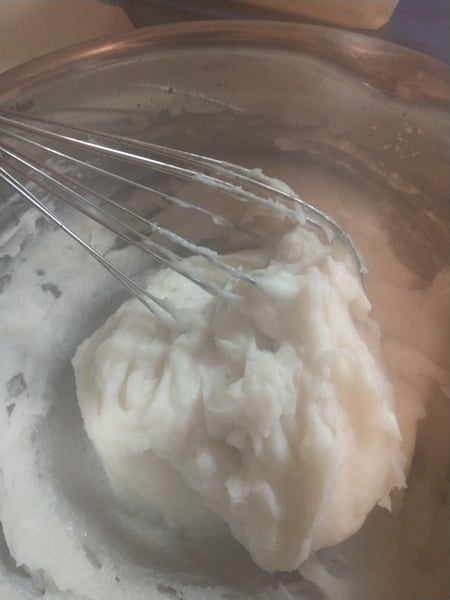Recipes usually have some sort of story attached to them explaining its history, how and why it has been modified, and the most important tips and tricks to make it work in your home kitchen. My little handwritten cinnamon roll recipe was lacking, so I had to turn to the internet to figure out how to make softer, fluffier cinnamon rolls.
All of my research landed on the Tangzhong method: a Japanese water roux technique. Simply put, the method was designed to add moisture to a dough making any dough softer and fluffier. So naturally I thought the Tangzhong technique would be my best option for better cinnamon rolls. In the end I was right, however something went wrong in the execution and I somehow had to turn a mess into a masterpiece.
I started by measuring and building the cinnamon roll recipe.
Cinnamon Rolls
Dough
2 3/4 cups all-purpose flour
1/4 cup sugar
1 quick-rise yeast packet
1/2 cup water
1 teaspoon salt
2 Tablespoons butter
Filling
2/3 cup brown sugar
1/4 cup butter
3/4 teaspoon vanilla extract
Glaze
1 1/2 cup powdered sugar
1/4 cup butter melted
2-3 teaspoons milk
Tangzhong
5 Tablespoons water
5 Tablespoons whole milk
3 Tablespoons plus 1 teaspoon
To prepare the Tangzhong, combine the water, milk and flour together in a medium saucepan until no lumps remain and the mixture thickens. Once thickened, remove from heat to cool.

In the bowl of a stand mixer, combine flour, yeast and salt.
In a microwaveable dish, combine butter, water, sugar and heat until the butter is almost dissolved.
Gradually add the milk and water mixture into the flour mixture until well incorporated
Add egg and mix until soft and sticky dough forms.
Add in the Tangzhong that has been cooling off to the side.
As the cinnamon roll recipe instructed, I changed to a dough hook on the stand mixer and let the dough mix until it became elastic. Once the dough reached the elastic state, I covered it and let it proof in a 200-degree oven for 5 minutes. Looking back, I think this is where the “mess” started. I remember thinking as I added the Tangzhong to the dough that:
- I might actually be killing my yeast because I didn’t let the roux cool long enough.
- Combining two separate recipes together was not a good idea.
- Confirming that I have just made a mess (and I actually, laughed out loud at myself!).
- Wondering how do I fix this?
I let the dough proof as the recipe instructed and formulated a plan in the case I really did mess up the dough. My fears were confirmed when I pulled the dough from the oven - not only did it not double in size like it was supposed to, but it was so super sticky that I could hardly remove it from the bowl. I knew for a fact that there was no way that I was going to be able to actually roll the dough into some sort of shape!
Plan B to the rescue (I learned years ago to always have a plan B in the kitchen – it elevates having a major meltdown and cooking disaster.)! I put the dough in a Pyrex dish coated in the butter that I would have used to spread over the cinnamon roll dough. I scooped out some dough, spread it across the dish as best as I could and sprinkled the cinnamon roll filling over it.
I repeated the process until I was out of dough and placed the dish in the oven at 375 degrees and let it bake for 30 minutes.
Thankfully I didn’t have any trouble with making the icing for the cinnamon rolls. I have to say I was nervous the entire time the cinnamon roll dough was in the oven baking. I wasn’t entirely sure that I had really done the best course correction of combining recipes but no matter the outcome I was determined to see this through to the end.
In the end, my experiment didn’t go too far off the mark.
- Were they cinnamon rolls? No.
- Did they taste good? Yes.
- Did the dough come out softer and fluffier? Yes.
2 out of 3 is not bad at all! And I learned some lessons:
- When experimenting, time is your friend.
- More hands-on research is needed on my part to really understand what Tangzhong does to dough: this will not be the last time I work with the Asian baking roux.
- The Tangzhong needs to be completely cooled prior to incorporating it into any yeast-based dough to avoid killing the yeast.
This is definitely a time to say practice makes perfect, so onward and upward as I perfect my cinnamon roll recipe. Next time, I'll just use one of The Chopping Block's tried and true recipes like Chef Sara Salzinski's From Scratch Cinnamon Rolls or these Sticky Pecan Cinnamon Rolls.
You too have the advantage of using our recipes, classes and videos that our chefs have simplified and perfected for your you. If you are ever in a quandary about a recipe, please use us as a resource, we are happy to assist you in culinary pursuit!
